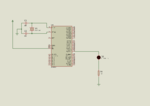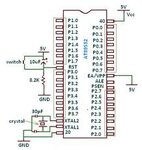Shaheers
Member level 2
- Joined
- Mar 24, 2010
- Messages
- 51
- Helped
- 3
- Reputation
- 6
- Reaction score
- 2
- Trophy points
- 1,288
- Location
- Islamabad,Pakistan
- Activity points
- 1,616
I am trying to implement a simple blinking circuit on bread board to checking purpose
I try for both atmel 89s52 and PIC18F452 for testing
I program 89s52 on Mickro C and Keil,
and PIC18F452 on Micro C and CSS C as well
I use old computer power supply to power them,
I am using Genius G540 to program them
both of circuits are works on proteus but not in real world,
is there any problem with crystal clock?
is there any problem in programming device, that device is using some sort of encruption while programming.
Is there any problem with power supply?
Is both of uC are faulty, even it programs and verify. . .. ?
the simple program in keil and sch are given
I try for both atmel 89s52 and PIC18F452 for testing
I program 89s52 on Mickro C and Keil,
and PIC18F452 on Micro C and CSS C as well
I use old computer power supply to power them,
I am using Genius G540 to program them
both of circuits are works on proteus but not in real world,
is there any problem with crystal clock?
is there any problem in programming device, that device is using some sort of encruption while programming.
Is there any problem with power supply?
Is both of uC are faulty, even it programs and verify. . .. ?
the simple program in keil and sch are given
Code:
#include <REGX51.H>
#include <stdio.H>
#include <math.H>
void main()
{
do{
int i;
for(i=0;i<10000;i++)
{
P2= 0x80;
}
for(i=0;i<10000;i++)
{
P2= 0x00;
}
}while (1);
}
